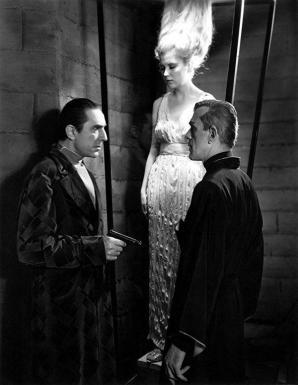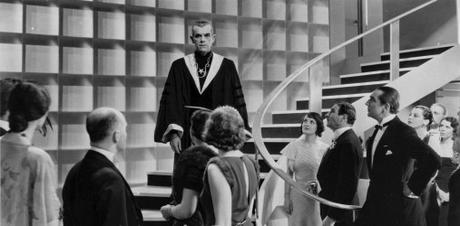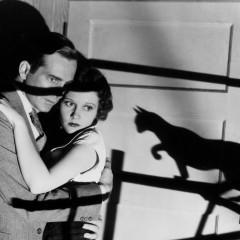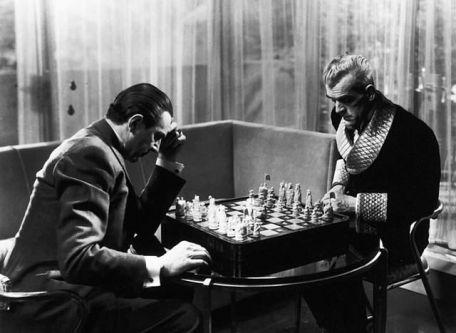Retro Review: 'The Black Cat'
With the dawn of the Universal Studios' venture to horror, it was very clear that actors,  Bela Lugosi and Boris Karloff were their two of the most biggest stars. It did not take a brain surgeon at the studio to realize that they needed to put the two actors together in one movie and watch the success roll in. Rising director Edgar G. Ulmer was chosen to take on the project, applying the name of Edgar Allen Poe's lurid story the Black Cat to the movie,despite it owing nothing to the tale. Released in 1934, the film was a bigger hit than they expected as it became Universal's highest grossing flick of the year and to this day is beloved by horror fans due to it's visual brilliance and the chemistry shared by it's two leads.
Bela Lugosi and Boris Karloff were their two of the most biggest stars. It did not take a brain surgeon at the studio to realize that they needed to put the two actors together in one movie and watch the success roll in. Rising director Edgar G. Ulmer was chosen to take on the project, applying the name of Edgar Allen Poe's lurid story the Black Cat to the movie,despite it owing nothing to the tale. Released in 1934, the film was a bigger hit than they expected as it became Universal's highest grossing flick of the year and to this day is beloved by horror fans due to it's visual brilliance and the chemistry shared by it's two leads.
In the nation of Hungary, a young couple on their honeymoon meet the mysterious and troubled Dr. Werdegast. They learn that for 15 years the doctor has been a prisoner of war fighting for his beloved nation, and is now returning home to have a long overdue meeting with his old acquaintance, an aloof architect named Poelzig. As misfortune would have it, the newlyweds are forced to join Werdegast to the old fort which Poelzig has completely redesigned into his own nightmarish Bauhaus-infused residence. Joan, the wife of the young couple is horribly injured leaving her and her husband at the mercy of the owner of the house and the doctor who knows his secrets. It is revealed that in dark recesses of the old fort, the preserved body of Werdegast's wife is held as a trophy by the mad architect, and the reason Werdegast is here is for revenge. Now with the naïve couple in his clutches, Poelzig plans to use Joan as a sacrifice to Satan as he and the doctor play their dangerously dark games against each other.
The reason Edgar G. Ulmer was entrusted with the director's chairs was the hope that he could bring a European-inspired flair to the Black Cat. Having trained under the tutelage of the German filmmaking pioneer FW Murneau as a young man, Ulmer was incredibly familiar with the German Expressionist style which inspired so many of the early horror


The biggest draw of the Black Cat was the casting of the two biggest horror stars of that decade, both of whom are revered to this day by genre fans. The year 1931 saw both men become stars as they portrayed the most iconic characters of their storied careers. Bela Lugosi moved from stage to screen in the lead of Dracula, and Boris Karloff stole the show playing the monster in Frankenstein. Edgar G. Ulmer, who spoke highly of both actors, said an interesting dynamic in making this film was how different the two men were. In an interview with Peter Bogdanovich shortly before his passing, Ulmer discussed how Karloff never really took himself seriously and would sometimes ruin takes during intense and frightening scenes by looking at the camera and going "BOO!" or making some offhanded joke. Contrasted with Lugosi who always took his work incredibly seriously, and the director had to work to bring him down between scenes. That being said the rivalry between the two perpetrated through Hollywood legend was far from the truth as the two actors were always friendly and professional with one another. I have always enjoyed the bit of role-reversal the two share in the Black Cat. Whereas Boris Karloff tended to play monsters who earned sympathy from viewers and Bela Lugosi tended to play more outright theatrically sinister characters, this flick sees Lugosi as the sympathetic Dr. Werdegast while Karloff

The Black Cat is nothing short of a horror masterpiece which delivers in both style and substance. Granted it has nothing to do with the classic short story (Lugosi's character has a fear of black cats, but that's about it) but it is hard to fault Universal for promoting a horror film using the names; Boris Karloff, Bela Lugosi, AND Edgar Allen Poe. Some mainstream critics have complained that the story gets muddled in the plethora of horrific elements. I have not found that to be the case, and even if it were the intensity of the lead performers combined with Ulmer's pitch perfect direction and stunning visuals easily gloss over those faults.

